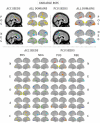Personality is reflected in the brain's intrinsic functional architecture
- PMID: 22140453
- PMCID: PMC3227579
- DOI: 10.1371/journal.pone.0027633
Personality is reflected in the brain's intrinsic functional architecture
Abstract
Personality describes persistent human behavioral responses to broad classes of environmental stimuli. Investigating how personality traits are reflected in the brain's functional architecture is challenging, in part due to the difficulty of designing appropriate task probes. Resting-state functional connectivity (RSFC) can detect intrinsic activation patterns without relying on any specific task. Here we use RSFC to investigate the neural correlates of the five-factor personality domains. Based on seed regions placed within two cognitive and affective 'hubs' in the brain--the anterior cingulate and precuneus--each domain of personality predicted RSFC with a unique pattern of brain regions. These patterns corresponded with functional subdivisions responsible for cognitive and affective processing such as motivation, empathy and future-oriented thinking. Neuroticism and Extraversion, the two most widely studied of the five constructs, predicted connectivity between seed regions and the dorsomedial prefrontal cortex and lateral paralimbic regions, respectively. These areas are associated with emotional regulation, self-evaluation and reward, consistent with the trait qualities. Personality traits were mostly associated with functional connections that were inconsistently present across participants. This suggests that although a fundamental, core functional architecture is preserved across individuals, variable connections outside of that core encompass the inter-individual differences in personality that motivate diverse responses.
Conflict of interest statement
Figures






References
-
- Canli T, Amin Z. Neuroimaging of emotion and personality: scientific evidence and ethical considerations. Brain Cogn. 2002;50:414–431. - PubMed
-
- DeYoung CG, Gray JR. Personality neuroscience: Explaining individual differences in affect, behavior and cognition. In: Corr PJ, Matthews G, editors. The Cambridge handbook of personality psychology. New York: Cambridge University Press; 2009.
-
- Digman JM. Higher-order factors of the Big Five. J Pers Soc Psychol. 1997;73:1246–1256. - PubMed
-
- Costa PT, Jr, McCrae RR. NEO PI-R Professional Manual. Odessa, FL: Psychological Assessment Resources; 1992.
-
- John OP, Naumann LP, Soto CJ. Paradigm shift to the integrative Big Five trait taxonomy: History, measurement, and conceptual issues. In: John OP, Robins RW, Pervin LA, editors. Handbook of personality: Theory and research. New York: Guilford Press; 2008. pp. 114–156.
Publication types
MeSH terms
Grants and funding
LinkOut - more resources
Full Text Sources
Other Literature Sources

